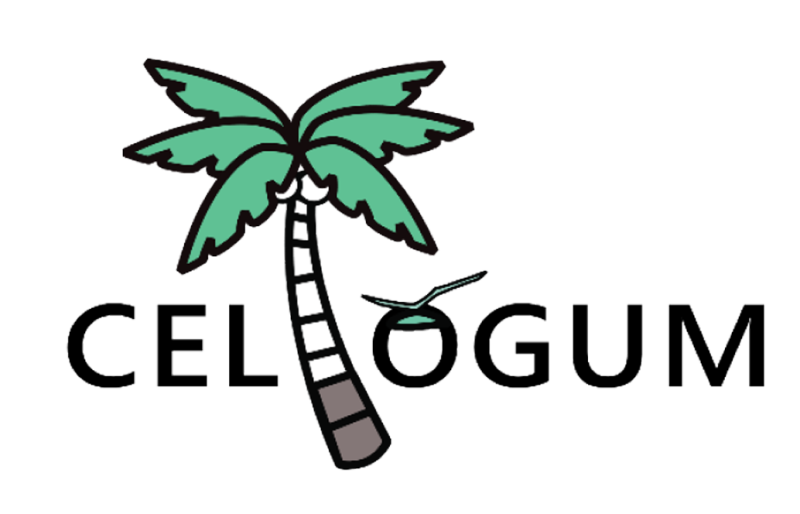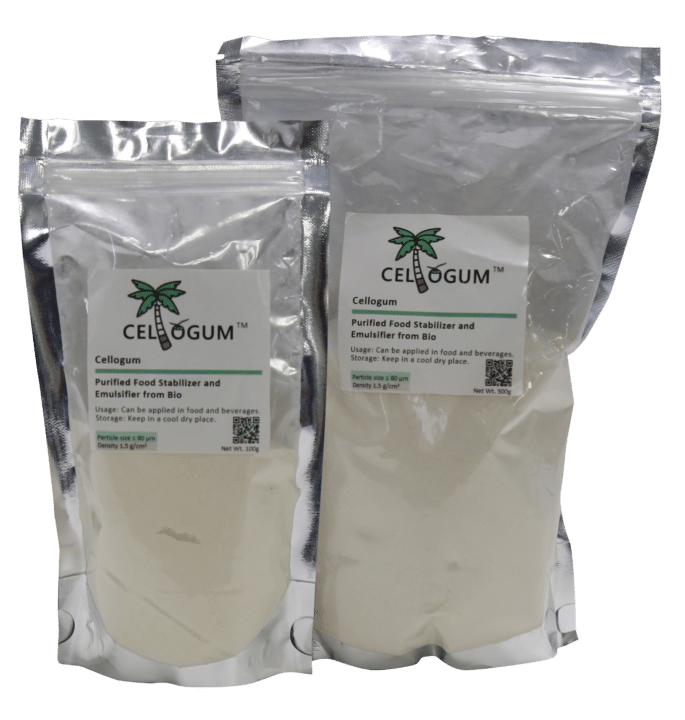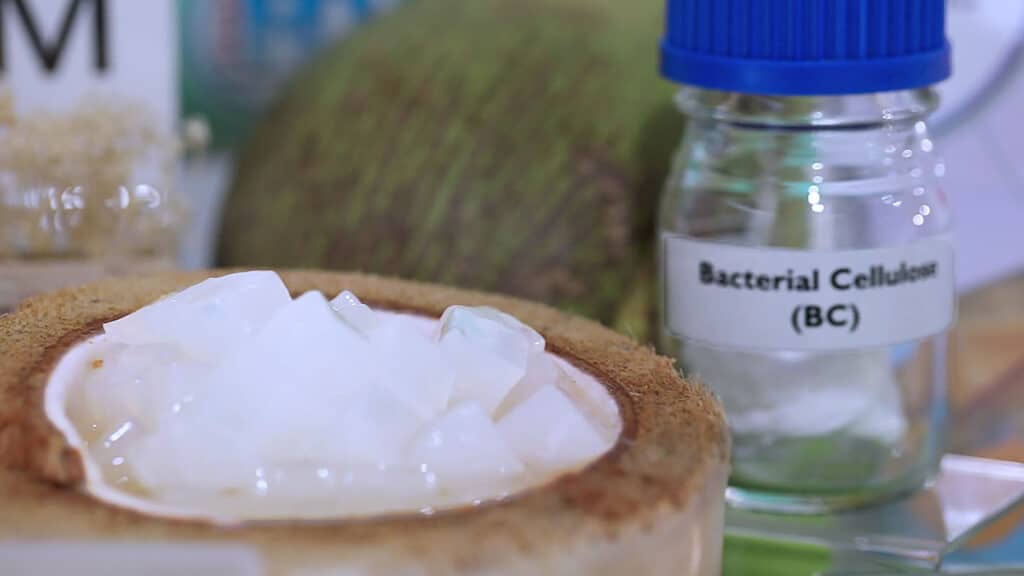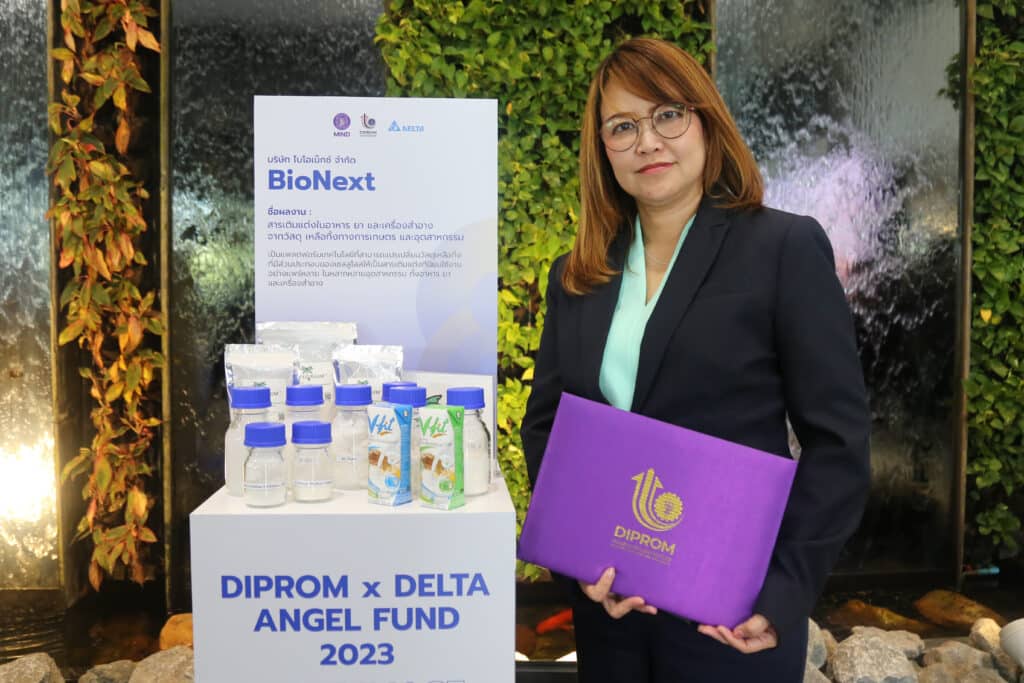
Cello-gum Innovation Revolutionizes the Food Industry: Turning Coconut Jelly Biowaste into Billions in Raw Material Value
“Cello-gum”, a groundbreaking innovation by Prof. Dr. Hathaikarn Manuspiya from the Petroleum and Petrochemical College at Chulalongkorn University, transforms coconut jelly biowaste into valuable food ingredients worth billions of baht.
This collaboration between Chula researchers and companies like Ampol Food Processing Co. Ltd. effectively repurposes tons of leftover coconut jelly scraps into efficient food additives. These additives can be upcycled for use in the food, pharmaceutical, and cosmetic industries, reducing the need for costly imported additives in Thailand.
The research team is confident that this success will set a precedent for circular economy development, aiming to increase the value of waste generated by the food and agricultural industries. This approach aligns with creating a zero-waste society, where nothing is left for incineration.
Prof. Dr. Hathaikarn Manuspiya from the Petroleum and Petrochemical College (PETROMAT)
What Exactly is “Cello-gum”?
Cello-gum is a nanocellulose product derived from coconut jelly, utilizing raw materials abundant in Thailand. The residual jelly scraps, typically discarded as waste from the coconut jelly production process, are ingeniously transformed into products that serve as effective additives in food, medicines, and cosmetics.
Prof. Dr. Hathaikarn Manuspiya, Director of the Center of Excellence in Petrochemical and Materials Technology (PETROMAT), lecturer at Chulalongkorn University’s Petroleum and Petrochemical College, and founder of BioNext Company Limited, led the research team. This team, which includes Assoc. Prof. Dr. Sarute Ummartyotin, Mr. Varoon Varanyanond, Mr. Phiyawat Sathidvongkun, and Dr. Pongpat Sukhavattanakul, deserves credit for the innovative idea that paved the way for this breakthrough. Beyond addressing the issue of food waste through circular economy principles, Cello-gum also has the potential to enhance the value of waste generated in the food production process.
In the words of Prof. Dr. Hathaikarn, “The additives are high in purity and safe. Given their market demand, Cello-gum stands as a good example of innovation with enormous potential for industrial development.”
Cello-gum
“Bacterial Cellulose” Research: Paving the Way for an Innovation That Enhances the Value of Coconut Jelly Waste
According to Prof. Dr. Hathaikarn, Chula possesses the expertise to apply bacterial cellulose to a chemical process using biotechnology, leading to the production of additives applicable across the food, medicine, and cosmetics industries. These additives serve as useful substances for controlling the viscosity and providing texture to various products.
“Food stabilizers play a pivotal role in industries such as food, cosmetics, and medicine,” explained Prof. Dr. Hathaikarn. In rice milk products, for example, additive substances are essential to maintain colloidal properties, preventing the milk from separating into layers. This enhances the texture, giving the product the appearance of containing rice. The same goes for fruit juices that often incorporate cellulose-based additives to augment content.”
Traditionally, research teams molded bacterial cellulose into membranes, presenting themselves in the form of food preservation film or labels. However, upon establishing connections with diverse groups in the food industry, particularly with companies like Ampol Food Processing Co. Ltd., a global exporter of coconut jelly, ideas flourished. This collaboration aims to leverage the knowledge of bacterial cellulose to create additives that add significant value to coconut jelly scraps.
“Upon discovering research on transforming coconut jelly scraps into high-value materials, the company expressed interest in such possibilities,” Prof. Dr. Hathaikarn elaborated. “Enormous amounts of scrap are generated daily during the production process and typically discarded through burning. By repurposing them into additives, we can contribute to reducing Thailand’s importation of various additives, which amounts to over ten billion baht per year.”
The collaborative project between Chulalongkorn University and Ampol Food Processing Co. Ltd. has gained recognition, being selected as one of twelve finalists in the Rising Star Project by the Office of the Permanent Secretary, Ministry of Higher Education, Science, Research, and Innovation in 2020. The initiative secured funding to establish a pilot plant dedicated to collecting coconut jelly scraps and transforming them into additives for use in the food, medicine, and cosmetics industries.
Chemically processed bacterial cellulose from coconut jelly
Why Coconut Jelly Shines as an Ideal Additive: Insights into Cello-gum’s Unique Qualities
Coconut jelly, or Nata de Coco, a natural material whose scientific structure is bacterial cellulose, or BC, possesses exceptional qualities such as strong mechanical properties, high porosity, and substantial water absorption capacity. It is easily moldable, biodegradable, and non-toxic.
“When used as a composite material or additive, coconut jelly enhances properties, such as ensuring good adhesion of other substances, and has various applications.”
The bacterium responsible for producing coconut jelly is Acetobacter xylinum, which can be cultured in a lab and fed with sugar and carbon sources, with “coconut water” serving as nourishment. When bacteria get fed, they excrete fiber, and this fiber is a good type of cellulose. Prof. Dr. Hathaikarn underscores the superior qualities of Cello-gum, noting its purity, efficiency, and economic benefits compared to imported additives.
Prof. Dr. Hathaikarn mentioned that, besides coconut jelly, various agricultural wastes, despite containing smaller amounts of cellulose, can be turned into cello-gum. “Unlike wood or other plants like bagasse or cassava, which yield only about 30% cellulose, coconut jelly provides more cellulose content. Additionally, the production process can incorporate bagasse, corn, and pineapple, albeit with potential alterations or additions.”
Prof. Dr. Hathaikarn and the awarded “Cello-gum” products
Prof. Dr. Hathaikarn and her research team
Cello-gum’s Future: What Awaits in the Years Ahead?
The future of “Cello-gum looks promising. Aside from being a finalist in the 2020 Rising Stars Project and securing the top spot in the Angel Fund project for 2023, the success of the pilot plant has prompted the establishment of Bionext Co. Ltd., a spin-off company from Chula’s College of Petroleum and Petrochemicals, Center for Excellence in Petrochemical and Materials Technology (PETROMAT), established through the incubation of CU Enterprise. This spin-off company aims to expand commercial production capacities and collaborate with various large companies. To do so, Bionext will test work development, conduct research, and propose projects.
The vision is to create a model where agricultural waste is reintegrated into the process, transforming it into products like cello-gum. The overarching goal is to establish a circular economy and achieve zero-waste.
Prof. Dr. Hathaikarn attributes the project’s success to crucial factors such as supportive colleagues, research teams, and contributions from partners and industrial groups. She emphasizes the importance of creating a robust ecosystem for sustainability, urging perseverance in the face of obstacles.
Cello-gum is actively seeking joint venture partners and assistance in engineering, including machinery design and factories for production, to evolve into a full-fledged industry. Simultaneously, the research team, led by Prof. Dr. Hathaikarn, plans to develop bacterial cellulose for use as a binder in the tablet press industry, additives in dietary supplements, and hydrogels in cosmetics.??
“Chulalongkorn University sets the standard as a university of
innovations for society and is listed in the World’s Top 100 Universities for Academic Reputation, in the Quacquarelli Symonds (QS) World University Rankings 2021-2022.”





